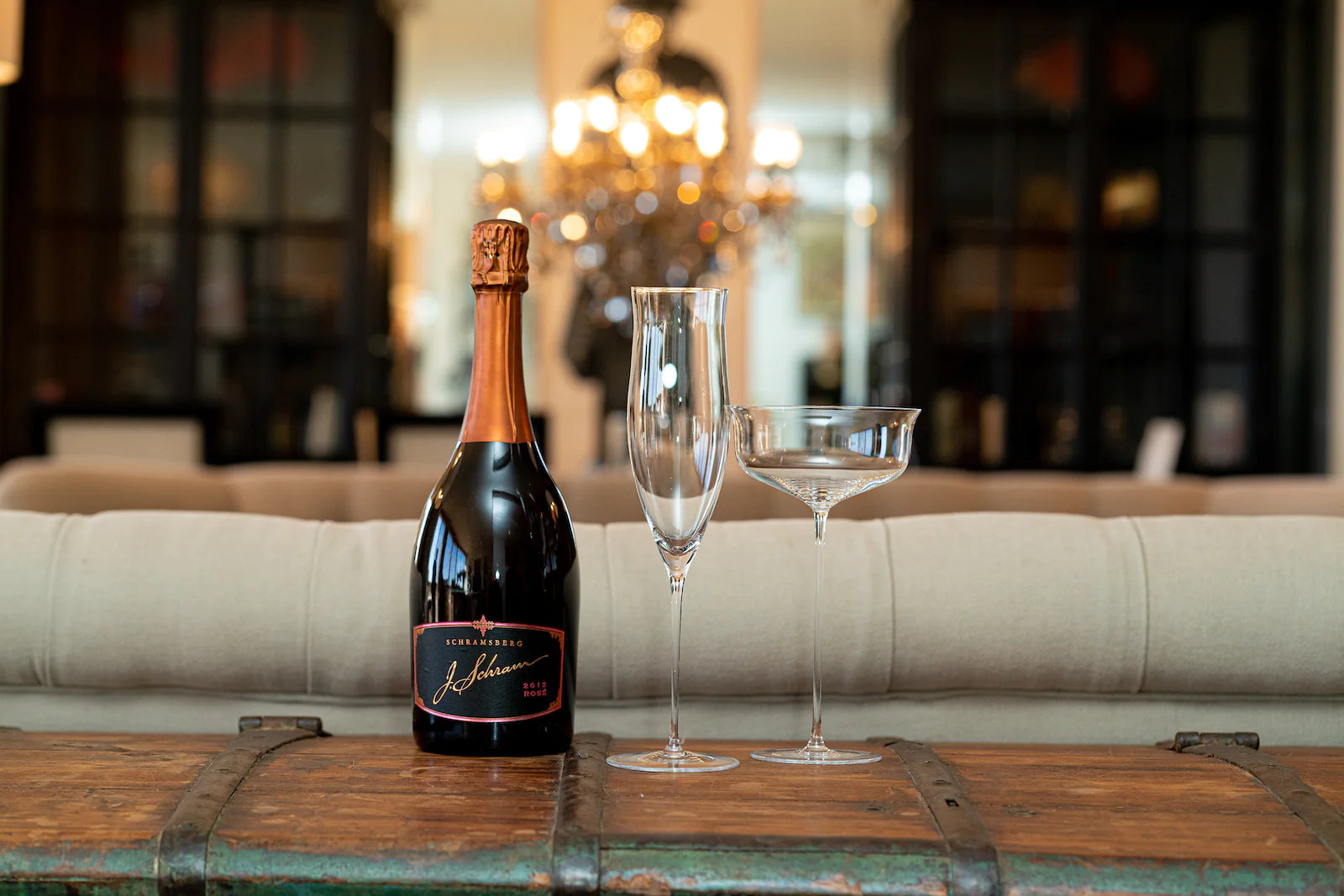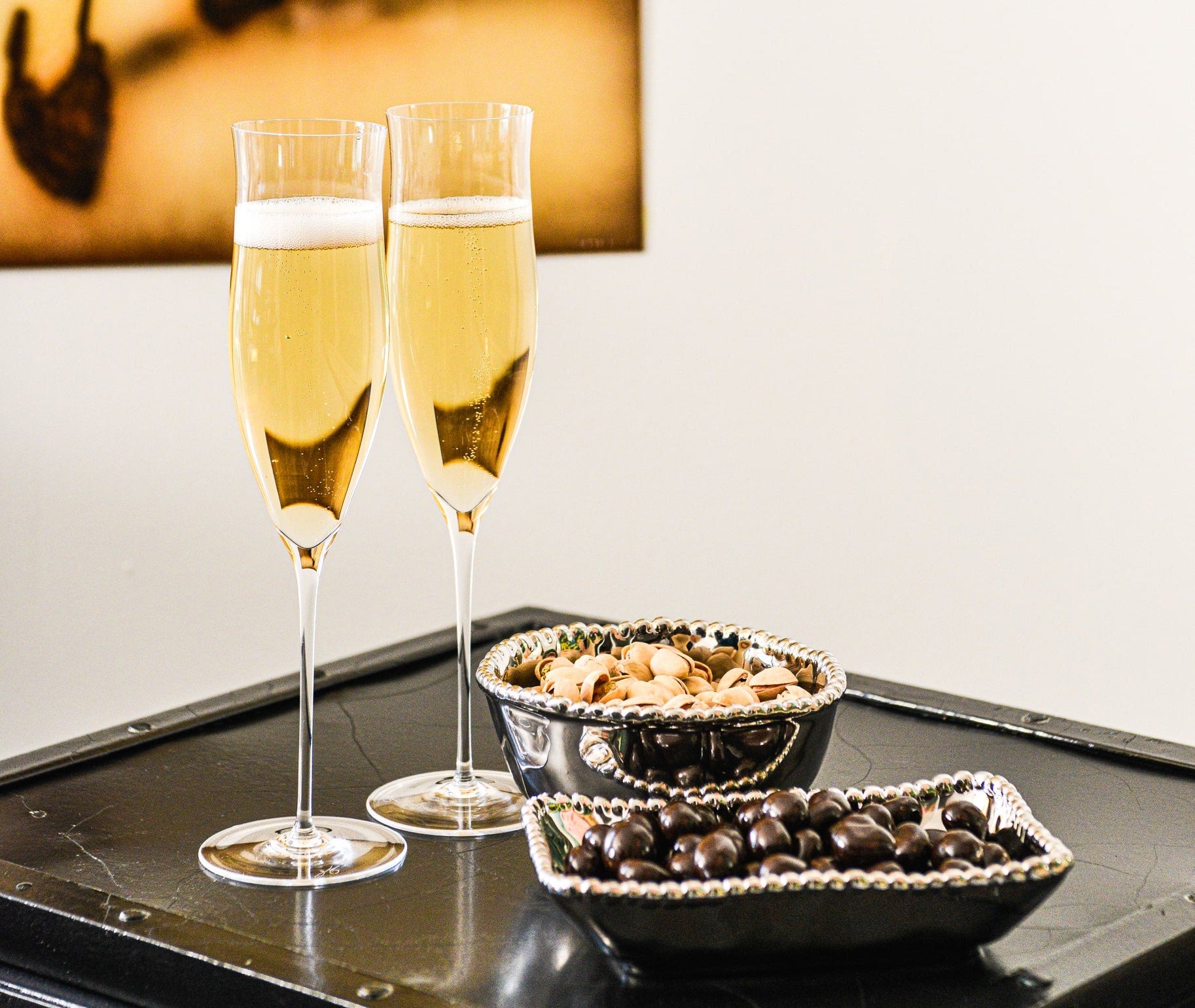Champagne, Home Entertaining
Different Types of Champagne: Guide to Types of Champagne to Try
From the history of champagne to the different types of champagne, this guide is an essential read for anyone looking to learn more about this fizzy drink.

We all know and love champagne as a drink for special moments, celebrations, birthdays, weddings - and (if you ask us) for whenever we feel like it! - but did you know there are many types of Champagne? Ones with no sugar added, and ones made to suit a sweet tooth? Knowing the difference will help you decide what type of Champagne to choose, whether it’s to pair with your favorite dish or which is best for a cheese platter at your next celebratory gathering.
As an educated and experienced tastemaker, I understand the simplicity of sophistication. Having served The Farm of Beverly Hills for more than twenty years as a highly-regarded restaurateur to designing a successful, self-curated collection of luxurious and practical glassware, I strive to find the best quality products for your home that create lasting memories.
With the help of this guide, you can transform your dining experiences by indulging in the finest Champagnes from around the globe.

What Grapes go in Champagne?
There are many different types of Champagne (and sparkling wine), all of which are made from various grapes grown around the world. Depending on where they were grown and produced, how aged they are, and the blend of grapes, there’s always a glass of Champagne to suit everyone’s unique tastebuds.
Three Main Traditional Champagne Grapes
- Chardonnay: Chardonnay is a green-skinned grape that produces a white wine, such as Blanc de Blanc. Notable regions where these grapes are grown include France, Italy, California, and New Zealand.
- Pinot Noir: Derived from the French word for “pine”, Pinot Noir grapes are red-skinned with white flesh that grow in pinecone–shaped bunches. These grapes are known for producing Blanc de Noir wines. As one of the hardest grapes to grow due to their demanding nature, Pinot Noir grapes are grown mainly in France and Oregon.
- Pinot Meunier: This variety of red grapes is often used in blending Champagne. Most often grown in Württemberg, Oregon, and Okanagan Valley, the Pinot Meunier grape yields a light, fruity taste.
Types Of Champagne From Dryness to Sweetness
- Brut Nature: This is the very driest of Champagne - also called Zero Dosage or Brut Zero, which means there is no added sugar in these bottles of Champagne. The “natural” simply stands for the natural sugars from the wine. Brut Nature is brisk and bubbly and pairs well with any meal.
- Extra Brut: A bit drier than Brut, but not quite as dry as Brut Nature, Extra Brut is often complementary to hard cheeses, like Parmigiano Reggiano, due to its high acidity.
- Brut: Brut is the French word for “dry, raw, or unrefined”. Brut Champagne is the most common sparkling choice, showcasing floral tones and hints of almond. A glass of Brut highlights fatty dishes including pasta, cheese dishes, and lobster.
- Extra Dry / Extra Sec: Despite its name, Extra Dry Champagne is a bit sweeter than Brut, due to its sugar content. This acidic bubbly can have anywhere between 0-6 grams of sugar per liter, depending on where the bottle was sourced. Try pairing an Extra Dry Prosecco with a variety of soft cheeses, such as brie, gorgonzola, or goat cheese.
- Dry / Sec: A Dry or Sec Champagne is just above an Extra Dry, containing 17-32 grams of residual sugar per liter. In a glass of this bubbly, you will taste a pleasant sweetness and various fruit flavors. This Champagne goes well with spicy and sweet foods, like Asian and Mexican dishes.
- Demi-Sec: This wine is half-dry to medium-sweet in taste and, when aged, will have more definitive flavors of honey and dried fruit.
- Doux: The sweetest of the Champagne types, Doux contains over 50 grams of sugar per liter. You can indulge as a dessert alone or pair it with other delicate sweet and salty treats.

Other Types of Champagne
- Vintage: This type of wine simply means using only grapes from a specific year.
- Sans Année: Made out of reserve wines of different years, the Champagne maker creates a ‘house brand’ with consistent taste and quality.
- Millésime: From a specific harvest year - usually a Brut - this Champagne or sparkling wine is produced with grapes from the same vintage year, each with a different character.
- Cuvée: A Cuvée is produced from exceptionally good grapes from different vintage years to create continuity of style.
- Blanc de Blancs: A white Champagne produced from white grapes, this type is often crisp and with lively acidity and tones of citrus fruits or meringue tarts.
- Blanc de Noirs: Made from red grapes, Blanc de Noirs is a white wine, distinct in red fruit flavors and freshness.
-
Rosé: Recently grown in popularity over the last several years, Rosé is produced in one of two primary methods:
1. Assemblage: Used by the majority of producers and created by adding a small amount of still red wine, usually Pinot Noir grapes. It is typically lighter pink in color and has brighter tones.
2. Saignée: The French word for “bleed or maceration”, this Rosé gets its color from leaving the red skins together with the white juice when pressing the grapes. It has flavors of raspberry, cherry, and even green bell pepper.
-
Grand Cru/Premier Cru/Autre Cru: These types of Champagne refer to the status and location of the villages the grapes have come from. The literal translation of ‘cru’ is growth. These classifications are still used to determine the historic qualities of the villages and vineyards. It is simply a historic ranking and is a great indicator of the quality of the grapes. Some Premier Cru and Autre Cru produce better fruit than some Grand Cru villages.
- 1. Grand Cru - Can only be used if 100% of the grapes are from Grand Cru villages.
- 2. Premier Cru - Can be used if the grapes are a mix of Grand Cru and Premier Cru villages or 100% from Premier Cru Villages.
- 3. Autre Cru - Uses grapes from other villages in the Champagne region.
Types of Champagne Producers: Three Main Varieties
- Maisons: Maison is the French word for “house”. Maisons make up 85% of the Champagne brought to the US. Some of the world’s greatest Maisons include Moët & Chandon, Veuve Clicquot, and J de Telmont.
- Cooperatives: Also called co-ops, cooperatives are growers who share a grape processing plant or farm. There are over 140 co-ops, with Centre Vinicole Champagne Nicolas Feuillatte (CVC) and Alliance Champagne being the largest.
- Vignerons: Vignerons are single estate growers, who cultivate grapes for winemaking within their own winery/farm.

Best Champagnes to Try According to Fran Berger
As a home entertaining designer and consultant with over two decades of experience, I truly understand the importance of creating wonderful experiences in the home. There is nothing more special than gathering with loved ones and making unforgettable moments - and luxury, high-quality housewares can do just that. I strive to curate environments for my clients that are both practical and beautiful, so that you will want to use your products every day, not just on notable occasions.
Glassware is the natural first product I am offering in the Fran Berger Living collection of accessible luxury homewares and of course, Champagne glasses were a top priority for this collection. Below, I have paired the best glasses with some of my favorite Champagnes that will make all your future occasions spectacular.

Best Champagnes
Dom Pérignon - Prestige Cuvée: A Prestige Cuvée is the best that a Champagne house produces, in this case, the house is Moët & Chandon. Dom Pérignon is a Champagne (not a Champagne house) that is always a blend of Pinot Noir and Chardonnay grapes.
Prestige Cuvée is always a vintage Champagne, with some years going unproduced, as typically there are only 6 vintages produced in a decade, but those should age gracefully for at least 20 years. It is dry with a fine small bubble and pairs well with any dish. It is also, by far, my favorite sparkling.
Krug - Grand Cuvée: Krug is a Champagne house - the Grand Cuvée is a blend of over 120 different wines and more than 10 vintages so each year that it is produced is a different Édition. For instance, the 170 Édition is a blend of 195 wines from 12 years - the youngest in 2014 and the oldest in 1998. It is a blend of all three classic Champagne grapes: Pinot Noir, Chardonnay, and Pinot Meunier. It is invariably dry, deep golden in color and has fine small bubbles
La Grande Dame - Prestige Cuvée: From the house of Veuve Clicquot and made from almost entirely Pinot Noir Grapes with some Chardonnay, the La Grande Dame is dry and silky with a small and fine bubble. It is always a vintage blend.
Ruinart Brut Rosé - Maison Ruinart: The very first Rosé Champagne made in the 18th Century, it is a blend of Chardonnay and Pinot Noir. It is also a very easy ‘food’ champagne, as it is smooth with a medium bubble and can be paired with almost any entrée.
J Schram Noirs: A sparkling wine from Schramsberg Vineyards in Napa Valley, J Schram Noirs is produced strictly in the méthode champenoise or traditional Champagne-making methods are used. This Champagne is mostly produced with Pinot Noir grapes. In 1969, the Schramsberg Blanc de Blancs was served in the Nixon White House to Premier Zhou En-lai from China, marking the first time that any American wine was served in any White House or State Dinner event.

Best Champagne Glasses for Each Champagne
Dom Perignon - Fran Berger Signature Champagne Flutes
Enjoy the benefits of a luxurious lifestyle in one of the simplest ways. My signature glasses are handmade, 100% lead-free, crystal glasses made in the Czech Republic, designed to upgrade any Champagne tasting experience - from a formal gathering to a simple, intimate moment. Enjoy the look and feel of their thin, delicate design with my favorite choice of bubbly!
Krug- William Yeoward Lally Champagne Flute
These stylish and unique flutes will compliment the rich mousse and lively bubbles of an aged Krug. Enjoy as part of virtually any tablescape.
Le Grande Dame - Baccarat Mille Nuits Flutissimo
Offered in an array of colors - Amber, Clear, Moss, or Red - the Mille Nuits Flutissimo highlights the darker, smoky tones of a Le Grande Dame.
Ruinart Brut Rosé - Moser Mozart Champagne Glass
The Mozart Champagne Glasses are one-of-a-kind pieces, with a unique design of Rococo accents and modern crystal. Watch as your glass sparkles while you enjoy a tart Ruinart Brut Rosé, with hints of peppermint and grapefruit.
J Schram Noirs - TableArt Ambassador Champagne Flute
Give your palate a treat when you pour J Schram Noirs into these classically-designed flutes. The elongated stems and narrow bowl simply heighten the tones of warm apple and caramel flavors from this champagne.
Elevate every occasion with the right Champagne varietal.
Whatever the occasion may be, no matter how simple, a glass of Champagne compliments every experience. Find the right Champagne for your next gathering and create incredible moments within your home and around your table. Elevate the experience with my champagne flute or coup. To learn more about the magic of high-quality, luxury homeware, read articles on the Fran Berger blog.





















